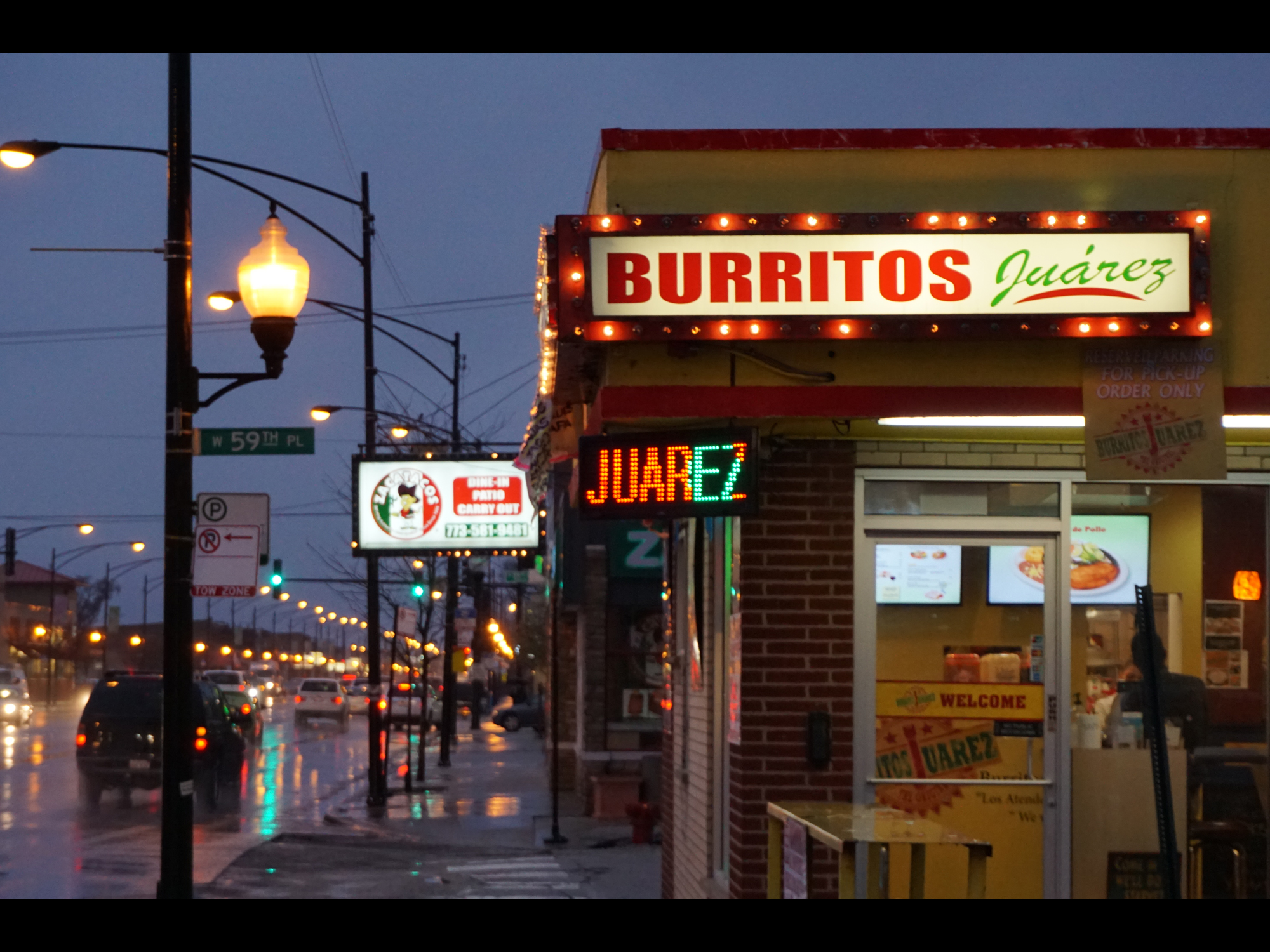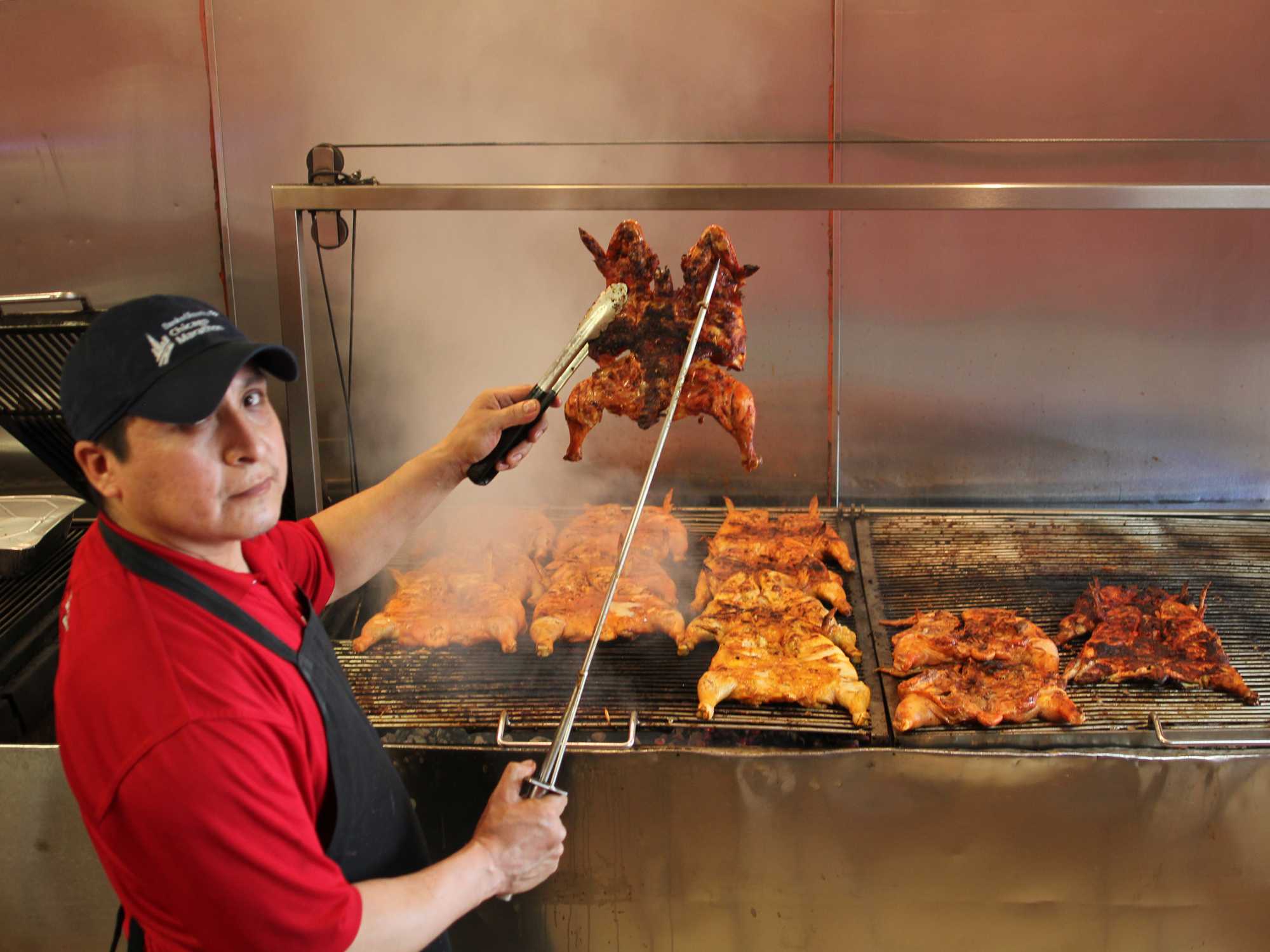ONLY TWO THINGS WERE STANDING in the way of Jared Leonard, owner of Rub’s Country Smokehouse in Rogers Park, finally serving the Nashville Hot fried chicken that he’s been working on for months—and that I tried a good six weeks or so ago. A location (The Budlong has one, on Western Avenue—and it’s still in construction and likely will be into summer), and a chef managing it on the premises.
The first fell into place earlier this week: The Budlong, his “pickle and chicken diner,” will open its first satellite location before its original location—in what was until earlier this week the Bunny, the Microbakery space at 2928 N. Broadway. Leonard said that he had been talking with Bowtruss owner Phil Tadros, partner with Elizabeth chef Iliana Regan in the bakery, about funding future expansion after The Budlong opened. Then, as the closing of Bunny came to look likely last week, Tadros approached Leonard to float his idea for that space—a small-scale burger joint.
“I didn’t want to think about another concept when this one hadn’t even opened yet. And I certainly didn’t want to get in the middle of the situation with Bunny. I wasn’t comfortable with that,” Leonard said when I met with him at Rub’s yesterday, and at that point he begged off. But when Bunny officially called it quits earlier this week, Tadros reached out to him again—and now it made perfect sense to launch The Budlong’s fried chicken in the small space. With a space ready to go, Leonard turned to another food scene figure he’s known for a while to run it—Jonathan Zaragoza, the chef son of the family that has much-beloved Birrieria Zaragoza on the south side, who’s worked at places from Sepia downtown to Masa Azul in Logan Square and Pearl’s Southern Comfort in Edgewater, where among other things he made… you guessed it… Nashville Hot chicken.

Hot chicken
Given the space, the Lakeview location will serve a shortened version of what will ultimately be Lincoln Square’s diner menu, which will include things like smoked pastrami (produced at Rub’s). But he will feature what he regards as the three main attractions—fried chicken, biscuits, and potato-flour doughnuts inspired by the vintage Spudnut chain, all of which will be offered on the opening date of May 10. (That means the flow of doughnuts to Lakeview will be almost uninterrupted. Praise the Lord!)
“It’ll have a packed energy to it. Lincoln Square will be a little more kid-friendly, and you can sit and be comfortable. Broadway will be more for that 28-year-old crowd that lives in that area—it’ll be busy, and probably some loud music, and you can see the guys making the food.” One thing he likes about is that the smallness of the space reminds him of divey Nashville chicken shacks like Bolton’s: “I think that tight space, but with the open ceilings, makes it feel not so claustrophobic, and the neighborhood is really busy. I think it’ll be really fun to get the system refined there and then take it to Lincoln Square.”
Okay, but this is a town where hot chicken is already hotter than hotcakes. So why should we get all het up about wanting Leonard’s version of the Nashville cult favorite? The reason is that, as he puts it, “The places that are doing hot chicken here are not really doing hot chicken here, not any of them.” And when Jared Leonard says he’s researched and tested something until it’s exactly right, you should believe him.
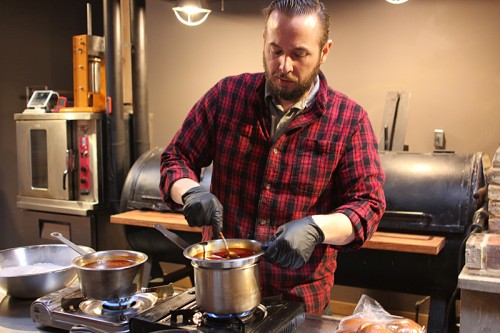
Stirring the hot sauce
I CAN THINK OF TWO RESTAURANT OWNERS who turned the space next to their restaurant into a stage for them to share their magic with the world. One was Charlie Trotter, who built his TV kitchen there. The other, more Bob Vila than Julia Child, is Jared Leonard, who turned an empty storefront in his restaurant’s building into a lecture hall for giving barbecue classes, backed by a smoker that looks like a steam locomotive, connected to a fire box over which he’s built a brick pizza oven (because once you have a fire going, why not make pizza too).
“The classes took off. I’ve taught 540 of them, almost,” Jared Leonard says. He had been doing the classes in the restaurant when it wasn’t open, but took over this space in June to be able to meet the demand for evening classes and private groups looking for dinner and a class. “I think I found a secret market in Chicago,” he explains, when I seem surprised there’s that much demand. “People who love barbecue, but don’t know anything about it. I get people who have a smoker and use it once in a while. Though I had some guys last week who’d been doing it for 30 years. So I get a mix, but I would say 90% of the people who take the class just take it for a night out, and it’s mixed guys and girls.”
So how many people has he taught this barbecue 101 to?
“About 10,000,” he says.
An army of Jared Leonard-taught backyard barbecuers roaming Chicago and the midwest, spreading the gospel of true ‘cue… we’re here today to talk about Nashville Hot chicken, dear friends, but to understand his chicken restaurant, The Budlong, you have to understand how Jared Leonard doesn’t do anything to do with food by half.
He’s a serial entrepreneur—he finally got into barbecue after starting and selling off a number of businesses in fields like e-commerce. But more than that, he’s a tinkerer, of the old American type that gave us automobiles and aviation out of guys fiddling around in garages. He starts to play with something, maybe just manages to get it going by the skin of his teeth, but then he’s committed to doing it all the way. (He’s on his fifth smoker at Rub; that might be a clue.)
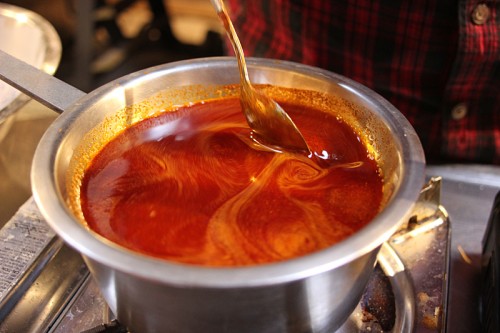
“In the beginning I was the wing-it kind of barbecue cook, but it would frustrate me that the food wasn’t the same every day,” he says. “Barbecue’s already hard enough, but then to have inconsistencies that you can’t understand—there are going to be inconsistencies because your brisket’s not going to be the same, so you try to control as much as you can.”
Leonard threw himself into really understanding what goes on inside a BBQ smoker or pit, and made himself an expert. “My wood guy, A-1 Country Wood, supplies about 80% of the wood to restaurants in Chicago. Whenever he gets a new client, who wants to talk science, he brings me in,” he explains. “A lot of people just throw wood in their pits, and don’t ever really focus on what the wood is doing. What BTU’s it’s providing, what smoke it’s putting out. And we’ve really scienced it out, because we don’t use any gas or electricity. From the three different pits we’ve used, to now the Bewley, which is really great for the science of fire because it doesn’t have random variables. It’s very consistent, which makes it easier to learn.”
That took a few years—Rub’s opened (under a slightly different name) in 2010, and he also co-founded the Windy City BBQ Classic, a KCBS-certified barbecue competition—but along the way he got an itch to do a fried chicken place. The reason was that, as a certain Kentucky colonel once showed the world, it’s a lot easier to replicate chicken shacks than barbecue joints. “Barbecue is all about my skills as a pit master. But a chicken’s going to cook in 14 minutes, whether I’m there or not.”

Slurry
And so he started a chicken quest. “When I started researching fried chicken—eating, reading about it, traveling—I thought barbecue would take the reign as the food that’s most diverse and different from area to area,” he says. “But fried chicken, man, there are a hundred different ways to do it and everyone has a very specific flavor profile. Like the Illinois River valley [southwest of Chicago], they just use a slurry. They don’t use any breading, like flour—they just use a wet slurry. So it’s a really thin batter. At a place like Ripp’s in Ladd, Illinois, they just dip it in the slurry and it goes straight in the fryer, so it’s really really crispy. We do a slurry, and then a breading.”
At some point, though, he had his Road to Damascus moment. “I was planning this fried chicken restaurant before I’d had hot chicken. So I was playing around with different recipes, and then I went to Nashville and had hot chicken, and went, THIS. This is special.”
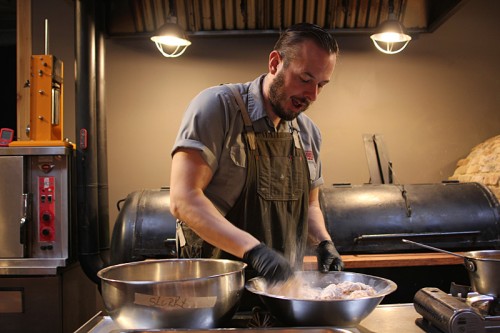
The Legend of Nashville Hot Chicken, As Retold by Jared Leonard
“75 years ago, Thornton Prince, who was this Nashville nightlife guy, African-American man who was into music, he liked to party, he liked to go out. He was just kind of well-known for that. And he had about six different wives, and he was with his girlfriend at the time—not even his wife. And he was out drinking all night long, and came home Sunday morning, and asked her to make him fried chicken for breakfast. And she was kind of like, you don’t get fried chicken when you’re out all night drinking, but okay. So she makes him fried chicken, and her intention was to hurt him, by adding cayenne pepper oil to this chicken to make it so hot that it would be unbearable to him. Not kill him, but cause some pain.
“Totally backfired on her. He was eating it and was like, this is the best fried chicken ever. I want to open a store that sells this fried chicken. So they opened a restaurant, I think at the time it was just called the Nashville Chicken Shack, it wasn’t Prince’s yet. And everyone loved this fried chicken.
“This was predominantly in the African-American neighborhoods, of course. But eventually white people started liking it too, and they would go into the African-American neighborhoods to eat hot chicken. And at one point, when segregation was still going on, there was a room in back of a couple of these places for white people.
“It wasn’t until the 60s that a place called Bolton’s opened, run by a guy who had worked at Prince’s. So Bolton’s opened, and you had a bunch of shacks—just like here when you drive around the south side and you have rib tips and hot links joints everywhere. Takeout windows, bulletproof glass—the same dynamic as those south side Chicago rib tip joints.”
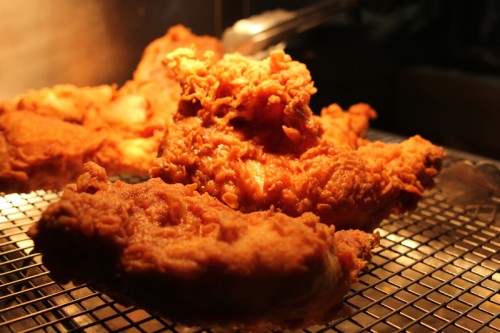
Freshly fried
LEONARD HAS A PAN OF CUT CHICKEN, and two variations of a hot sauce bubbling on the stove in his demonstration kitchen/mancave. “Originally, I was going to do an herb bird. But I want the focus to be Nashville Hot. I think it’s a cool theme. We’ll have chicken tenders for kids, too.” His plan is to offer four levels—the first being simply plain fried chicken, what he calls Naked. The next up from that is Mild, then Medium, which is roughly where we’re headed today.
And then there’s Super Hot. “We’re gonna make it special. We’re going to make it make-you-cry hot,” he reveals, then admits, “I personally don’t like it so hot that it makes you beg for mercy. But a lot of people think that’s fun, even if it’s not what they order every time, just as a drunken dare or whatever. I think just paying homage to the original, like Prince’s or Hattie B’s, you gotta have a fiery super-hot. Most of them even have a warning on the wall, like I think at Prince’s it says, ‘Choose your heat level wisely—no refunds.’ Because some big dude’s coming in there all badass, I’m gonna get that hot chicken, and he starts eating it and he’s crying like a baby.”
He dips the chicken in the slurry and we go back to the fryer in his catering kitchen. We fry up some boneless thighs for chicken sandwiches, as well as some whole thighs and legs, as he explains how Nashville Hot is properly dressed. “You take hot oil out of your fryer—you want to make sure it has the same profile as the chicken. And you want to make sure it’s hot, or it’ll just make the chicken greasy. KFC does hot chicken now, and they have a squeeze bottle with the hot sauce in it, and if it’s not hot, it just makes the chicken greasy. If the oil’s hot, it doesn’t absorb into the breading quite as much.”
Barbecue is all about my skills as a pit master. But a chicken’s going to cook in 14 minutes, whether I’m there or not.
When the chicken’s done, we bring it back out to the kitchen. He arranges two identical rows for the two variations on the sauce, and then starts to spread the sauce with a spoon. “The original formula for hot chicken was two parts cayenne pepper to one part lard. It was just straight up cayenne, which has that kind of bitter spice to it, it’s not like a habañero pepper where you’re like ‘AHHHHH,’ it hits your tongue and you can’t taste anything else.”
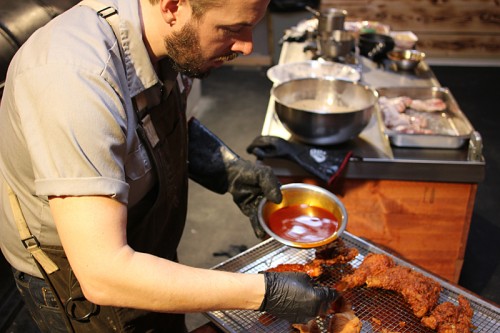
Ladling hot lard over seems like a recipe for making something unbearably greasy, but as promised, it doesn’t make the crust fall apart—it just stains it a nice mahogany. “When they do it with lard it’s almost like a paste. Like the original Prince’s, the lard and the cayenne was almost like butter, and they’d take it and put a dollop on the fried chicken. I think that makes the chicken greasier, but that’s how they used to do it.”
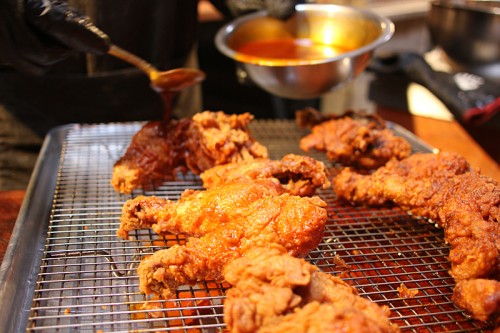
He describes the first version as the “more well-rounded,” with a little brown sugar and spices like onion powder to give it more variety. The second one is the one that Thornton Prince’s gal cooked up as revenge. I try them both. The first one, indeed, offers the pleasures of well-seasoned chicken that happens to be hot, while the second one is just about cayenne—but again, it isn’t a heat that feels like something just sliced your tongue; it’s a subtle heat that takes a little while longer to stoke your internal furnace. Both versions have all the other virtues of well-made fried chicken—lots of crunch, juicy meat, nostalgia for Mama. Either way, it’s good.
So what makes it true Nashville Hot in a way no one else’s is, as he claims? “I don’t mean that they don’t do it well. I hope this doesn’t sound like trash talking,” he says. (Because nobody ever does that in southern food.) “But like Leghorn, their spice is a habañero pepper spice. And you can call that spicy fried chicken, but Nashville Hot, if it was invented by a guy with cayenne pepper and you’re gonna call it that, we should stick true to that, you know? And The Roost—I really like their fried chicken, I think it’s really good. I had their Nashville Hot a couple of weeks ago and I just didn’t like it that much—I think his herb bird is better than his Nashville Hot, that’s all I’m gonna say. I’m not going to argue about authenticity, I don’t know what he’s doing to it. But his herb bird I thought was a lot better.”
“On Armitage, Parson’s, the first time I went there I swore I would never go again, because it was the first summer they were open and service was obnoxious and people were busy and lines—and I hate that. Went back during the winter, when they’re not very busy, and man, I was impressed. They don’t call it a Nashville Hot, they call it Parson’s Hot, which I thought was appropriate. But he again uses cayenne, brown sugar, onion and garlic powder, it’s really well rounded.”
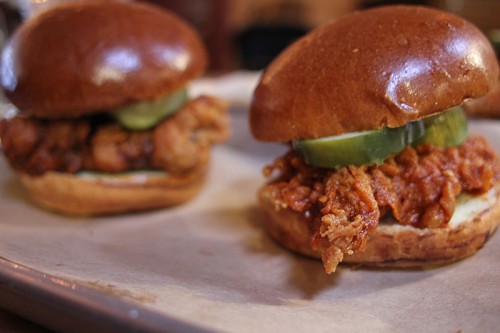
Sandwiches add a housemade pickle for a little sweet and sour action.
SOMEONE WHO’S WILLING TO BE THAT ANALYTICAL about his competition warms a food writer’s heart. So I press him again for the story of how he wound up at this place in life, sciencing the hell out of barbecue and fried chicken. Had he always been interested in cooking?
“Growing up, my mom worked, and we had four boys, and one of our chores was helping my grandma cook dinner. At first, it was just for fun, but as we got older, it was, you’re in charge of dinner tonight. And my grandparents owned a farm, so there was a lot of canning and preserving, what poor people did, before it was cool.
“I went away to college and literally, I’m the only one who knows how to cook. One of my roommates, he was going to make mac and cheese so we’d have something for dinner, and he literally asks me how I know when the water’s boiling. So in college, I was the guy who would have people over. Now I’d have a pop-up dinner, and sell tickets through Tock.
“I dropped out of college because I was going to college to be a lawyer. And I met this guy who was a lawyer, and he really depressed me. So I decided I was going to be an entrepreneur. I was the guy who’d start a business, but as soon as it was going, I sold it, because I didn’t have any passion for the underlying subject matter.
“I wound up in Colorado, and met these guys who were cooking barbecue on the side of the road. And it was kind of a bittersweet moment for me. I grew up on Twin Anchors, and Gale Street Inn, and we had a place in DesPlaines called Old Town Ribs—just the sauced-up, nasty, meatloaf ribs. So when I started eating their barbecue, I was like, why don’t we have this in Chicago?
“I came back to Chicago, and it was the heyday of e-commerce and Ebay, so I was selling stuff—and cooking barbecue on the side. And then I was trading equity options—and cooking barbecue on the side. So I finally had a passion, and I started looking for what it would be like to have a food business. Because of course everyone tells you, don’t do that, it’s terrible and you should just give me a pile of your money to set on fire instead, you know?
“So Rub opened in 2010. We’re different than we were then. Back then we were just a husband and wife team cooking kind of homemade, backyard food. Then I started getting better at dialing in the science of barbecue and developing better instincts, and doing it every single day. Then I started teaching the classes—because that’s the best way to learn anything, right? Learn enough that you know more than most people, and then start teaching.
“And 200 classes later, your thought process has explored it so many times. Honestly, I’ve learned more teaching than cooking,” he says.
Now that’s the man whose fried chicken you want to try.
Michael Gebert wouldn’t do his woman no wrong that would require chicken-based punishment, as editor of Fooditor.
Latest
Join the Discussion
After you comment, click Post. If you're not already logged in you will be asked to log in or register with Disqus.




